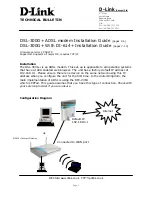
Q-Flex Satellite Modem Installation and Operating Handbook
7-8
For end-to-end buffering, with a Doppler allowance of 2ms:
Bs = 0.002 + 172800 x Ms x (Lc + Rc) seconds.
Using the bracketed example figures above gives a result of 0.00898 seconds, requiring a
buffer size of 9ms to absorb the plesiochronous effects. To this must be added any Doppler
requirement (e.g. 2ms for each satellite hop).
7.1.3.4 G.703 Clock Extension
The modem can provide a highly stable GPS-derived clock from a hub modem to a
remote modem, thereby saving the cost of installing GPS devices at both ends of the link.
The implementation involves the use of the G.703 interface card in the modem but the
resulting high-stability clock can be used in conjunction with any modem terrestrial
interface (such as IP).
The method involves extending a G.703 T1 or E1 timing reference to the remote end of a
satellite link, regardless of actual data rate required for the link.
This is achieved via a G.703 clock extension feature that propagates a high-stability
reference from the
hub
to the
remote
. It requires a high-stability E1/T1 reference signal
(ideally from a GPS receiver) to be fed to the hub modem (via the G.703 balanced or
unbalanced connectors).
The remote modem will then generate a T1/E1 output signal synchronized to the local
modem’s GPS signal. This signal can then be used for synchronizing the remote site
equipment.
To set the G.703 clock extension in Tx, set the Tx clock source to
Internal
at which point
the option to forward the G.703 clock as a clock reference over satellite will be presented.
To use the G.703 clock extension in Rx, set the Rx clock source to
Satellite
at which point
the option to generate a G.703 clock from the satellite clock will be presented. This will
result in the modem generating an Alt1/0 timing reference signal at either T1 or E1
through the G.703 interface card.
7.2 Automatic Uplink Power Control
Authorisation from the satellite operator should be sought before
AUPC is activated.
7.2.1 Introduction
Automatic Uplink Power Control (AUPC) provides a mechanism to counteract changes in
atmospheric conditions, such as rain, that degrade the performance of satellite links. It
does this by monitoring the remote-end signal-to-noise ratio (Eb/No) and automatically
















































